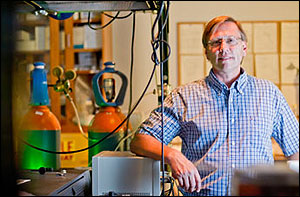
NIR Light Enables Deep Look at Cells
A “game-changing” technique using near-infrared light enables scientists to look deeper into the guts of cells, potentially opening up a new frontier in the fights against cancer and many other diseases.
University of Central Florida chemists, led by Kevin Belfield, used near-infrared light and fluorescent dye to take pictures of cells and tumors deep within tissue. The probes specifically target lysosomes, which act as cells’ thermostats and waste processors and which have been linked to a variety of diseases, including types of mental illnesses and cancers. The probes can be adapted to search for certain proteins found in tumors, which means they someday may help doctors diagnose and potentially treat tumors.

(Photo: Jason Greene)
“This is a game-changer,” Belfield said. “Until now, there was no real way to study lysosomes because existing techniques have severe limitations. But the probe we developed is stable, which allows for longer periods of imaging.”
Current imaging probes work for only a few minutes. They cannot penetrate deep tissue, are sensitive to pH levels and have poor water-solubility. Belfield’s technique gets around those problems by using near-infrared light. Once researchers identified the correct light frequency, they took images of lysosomes for hours.
The new approach will allow researchers to see lysosomes at work and to piece together their role in diseases such as cancer and Tay-Sachs, a genetic disorder from which children typically die by age four.
“We’ve come up with something that should make a huge difference in finding answers to some very complicated conditions,” Belfield said.
Belfield’s findings, which include comparisons to the only two existing probes on the market today, are published in this month’s Journal of the American Chemical Society. Belfield published three other papers this summer looking at probes that were adapted to search for proteins found in tumors. Those articles were published in Organic and Biomolecular Chemistry and the Journal of Organic Chemistry.
The National Institutes of Health’s National Institute for Biomedical Imaging and Bioengineering funded the project. Belfield’s team is continuing its research with NIH funding. The UCF researchers are working with the Sanford-Burnham Institute for Medical Research on the tests required before clinical studies can begin.
For more information, visit: www.ucf.edu
Published: September 2010